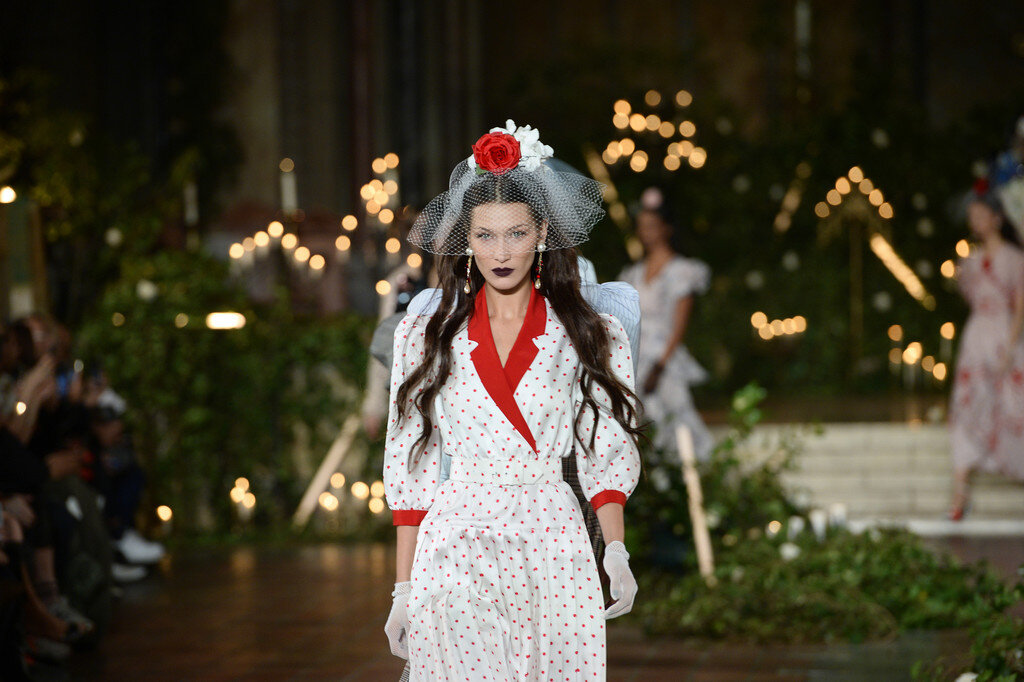Rodarte took us to church last night for the debut of the brand’s Fall Winter 2020 collection. St. Bartholomew’s Church in New York was reimagined by the runway show productionist Alexandre De Betak, who incorporated greenery, metal benches and modern light into the church’s reference dense nave. Atop of each seat rested a heart shaped box of chocolate for the attendees, who sat in silence during the sporadic flashes of the artificial light show; intense amidst the candlelit greenery.
The lights finally dimmed and out walked Bella Hadid from behind the altar, to the somber tune of “Miranda” by Slowdive. Miss Hadid wore a red and white 1950s housewife dress adorned with polka-dots and was fastened with a short bridal veil barely covering her eyes. Possibly a referential nod to the televised marriage in the Mad Men series, which was shot in the same church. The 1950s housewife trope was subverted through hair and makeup, which Oldile Gilbert, the hairstylist for the show, said was a reflection of Rodarte’s inspiration for the collection: “the wife of a vampire.” Portraying this woman was achieved in hair and makeup through the application of deep burgundy lipstick on the models and curling waves into many of the model’s, long, middle parted hair.
Meghan Roche followed by a 20-foot long bridal train. Photo: Vogue.com
Nods to vampirism were prevalent in the design of the dresses throughout the show, from bejeweled spiders as accessories, to Victorian ruffles and hooded outerwear made from black satin and navy velvet. Rodarte’s puffed sleeves and straight legged pants were designed with baroque embellishments for goth aesthetes. The fashion director for Garage Magazine, Gabriella Karefa-Johnson, noted how Kate and Laura Mulleavy’s designs for Rodarte are capable of making her “so moody and angsty, and feel like a bitchy witch” - a sentiment which truly captured the emotional promise of the collection. Low-hanging fringe, spiderwebs, capes and dresses with a compositional likeness to nightfall also underscored this aspect of the show.
The counterpart to vampirism in the collection added a much brighter component, which was the bridal aspect of the show’s theme. A mix of bohemian white dresses accentuated with jewels, florals and sheer gowns were among those inspired by bridal wear. Bouquets were reconceptualized as floral boas and beaucoup de flower arrangements were set in place of crystal tiaras. Model Meghan Roche closed the show in a floral headpiece that delicately outlined her face. This was paired with a matching baby-blue train, which was so massive it had to be managed by five crew members on the runway. Lace gloves and A-line silhouettes also complimented this theme throughout the collection.
So, what’s up with the vampirism? Perhaps it is the role of monsters in literature and film, which are most often understood as symbols of cultural anxieties. The role of vampires in particular has a rich history of communicating identity conflicts; dating back to the 19th century. Might not the Mulleavy sisters be tapping into this by incorporating bridalwear and 1950s designs into their womenswear show? The idea of siring the 1950s housewife into a vampire puts a gothic and sort of frightening spin on the concept of an otherwise docile woman. This sort of misbehavior is exactly what makes Rodarte’s elegant gowns so playful and unique.
Rodarte’s bitchier take on the 1950s housewife hits a chord with women who are at a psychological or actual crossroads in life, trying to choose a path or imagine their future selves. Someone who has a hard time identifying with the polarizing clichés of contemporary womanhood; being a career woman who gives up on forming a family or being a homemaker, whose only focus is family. The collection casts an interesting light on this conflictive experience. Ultimately showing that the identity of the woman wearing a Rodarte dress is defined by her own volition rather than the ideas of femininity that confront her. With dresses that range from sheer materials strewn with naive daisies to dark and heavy velvet gowns - there is something to cater to the rebel inside every woman.























Why the American fashion capital and its millennial consumer seem to be obsessed with nostalgia, how The Row outdid itself again, and the controversial element in Raf Simons’s looks…